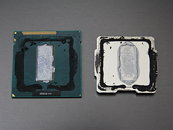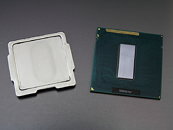Saturday, May 12th 2012

TIM is Behind Ivy Bridge Temperatures After All
It's proven: the thermal interface material (TIM) used by Intel, inside the integrated heatspreader (IHS) of its Core "Ivy Bridge" processors are behind its higher than expected load temperatures. This assertion was first made in late-April by an Overclockers.com report, and was recently put to test by Japanese tech portal PC Watch, in which an investigator carefully removed the IHS of a Core i7-3770K processor, removed the included TIM and binding grease, and replaced them with a pair of aftermarket performance TIMs, such as OCZ Freeze and Coolaboratory Liquid Pro.
PC Watch findings show that swapping the TIM, if done right, can shave stock clock (3.5 GHz, Auto voltage) temperatures by as much as 18% (lowest temperatures by the Coolaboratory TIM), and 4.00 GHz @ 1.2V temperatures by as much as 23% (again, lowest temperatures on the Coolaboratory TIM). The change in TIM was also change the overclockability of the chip, which was then able to sustain higher core voltages to facilitate higher core clock speeds. The report concluded that Intel's decision to use thermal paste inside the IHS of its Ivy Bridge chips, instead of fluxless solder, poses a very real impact on temperatures and overclockability.
Source:
PC Watch
PC Watch findings show that swapping the TIM, if done right, can shave stock clock (3.5 GHz, Auto voltage) temperatures by as much as 18% (lowest temperatures by the Coolaboratory TIM), and 4.00 GHz @ 1.2V temperatures by as much as 23% (again, lowest temperatures on the Coolaboratory TIM). The change in TIM was also change the overclockability of the chip, which was then able to sustain higher core voltages to facilitate higher core clock speeds. The report concluded that Intel's decision to use thermal paste inside the IHS of its Ivy Bridge chips, instead of fluxless solder, poses a very real impact on temperatures and overclockability.




219 Comments on TIM is Behind Ivy Bridge Temperatures After All
Improved Memory controller
PCI-E 3.0 - If you want this then your getting a new board and USB 3.0 native support and other improved perks like improved memory speed support on boards.
People upgrade for farless especially the so-called Enthusiast. 3770K and 2600k/2700k are all mainstream chips. I agree if you have a 2nd Gen i-Chip there isnt much to it. Although if your coming from a 1st gen i-Chip or lower the $10-$20 dollar differance is a no-brainer to go with Ivy-Bridge.
However, its a good reference point at displaying differences between a single variable and stock.
Its more of a look we found an issue so we pile on and everyone seams to jump on the bandwagon to justify there purchase or lack of it.
More like a child saying no I want same temps and same volts on I-B that I had on S-B, no no no..
I dont know, I bet 1% of people here it will make a differance to. The overcloakers that arent penny pinching. Could probably count them on one hand but then again they arent buying mainstream chips either.
There goes that theory eh? :banghead:
So ivy takes the mobile market as thats what tocks are practical for as being improved process and lower power/TDP while they keep the high end with sb extreme where for thst market po wer consumption isnt as important as max overclock and oc headroom.
I-5 3570K Review including power usage at stock and overcloacked
Well to say your not concern with it is one thing but saying its wasnt there is ignoring a feature and an improvement thats there.
:toast:
If you think about it, today's IB i5's at stock clock are probably comparable to a 4600mhz qx9650. So a 5ghz 2700k is probably comparable to the next gen's processors at stock clock. Basically a free 3 years of RnD.. surely that costs intel some money?
I don't agree with them however. I think it was really stupid. :p
AMD still uses paste, I think.
To me, Ivy Bridge is most interesting in low power applications. Can't wait to see the new ultrabooks. For desktop, bring on Haswell...
like this:
You can pretty much guarantee that extreme guys are gonna want one.
Your AMD pic reminds me of when I tried buying a shim for my Athlon XP. I put it on, put the paste on and then the heatsink... and the CPU nearly burned up through lack of proper contact. That particular bit of metal found itself in the bin in no time flat.